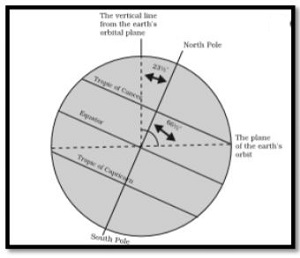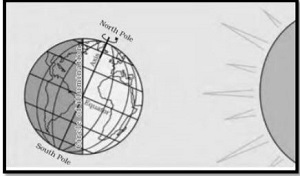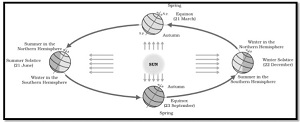The Earth has two types of motions namely, rotation and revolution.
Rotation is the movement of the earth on its axis. Days and Nights take place because of rotation.
Revolution is the movement of the earth around the Sun in a fixed path or orbit. Revolution causes the change of seasons.
Orbital Plane and Circle of Illumination:
The plane formed by the orbit is known as the orbital plane.
The axis of the earth which is an imaginary line, has an angle of  with its orbital plane.
with its orbital plane.
• The spherical shape of the Earth allows only half of the sun light to come at a time.
• The portion facing the sun experiences day while the other half away from the sun experiences night
The circle that divides the day from night on the globe is called the circle of illumination.
• The earth takes about 24 hrs to complete one rotation around its axis.The period of rotation is known as the Earth-day.This is the daily motion of the earth.
Revolution:
(i) The second motion of the earth around the sun in its orbit is called revolution.
(ii) It takes 365 days and 6 hours (one year) to revolve around the sun.
(iii) We consider a year as consisting of 365 days only and ignore six hours for the sake of convenience.
(iv) Six hours saved every year are likely to make one day (24 hours) over a span of four years.
(v) This surplus day is added to the month of February.
(vi) Every fourth year, February is of 29 days instead of 28 days. This year with 366 days is called a leap year.
(vii) The earth goes around the sun being inclined in the same direction throughout the year, in an elliptical orbit.
Seasons:
(i) Seasons change due to change in the position of the earth around the sun.On the basis of change in the position of Earth,a year is divided into summer,winter,spring and autumn.
(ii) On21st June the Northern hemisphere is tilted towards the sun.These areas receive more heat because sun rays fall directly on the tropic of Cancer.
(iii) On the other hand ,areas near the poles receive less heat as the rays of the sun are slanting.
(iv) The places beyond the Arctic Circle experience continous daylightfor about six months.As the larger portion of Northern hemisphere gets light from sun,it is summer in Northern part of equator.
Summer Solstice:
In summer season ,the regions north of the equator experience the longest day and shortest night on 21st June.It is opposite in southern hemisphere and the nights are longer than the days and is winter season there. This position of the earth is called as summer solstice.
Winter Solstice:
On 22nd December the Tropic of Capricorn gets direct rays of the sun as the South Pole tilts towards it.The days are longer with shorter nights in Southern hemisphere and it is summer in Southern hemisphere and winter in Northern hemisphere. This is called winter solstice.
Equinox:
On 21st March and 23rd September, direct rays of the sun fall directly on the equator. During this period, the whole earth experiences equal days and equal nights because neither of the poles is tilted towards the sun. This is called an equinox.
Question 1. Answer the following questions briefly.
- What is the angle of inclination of the Earth’s axis with its orbital plane?Answer:The angle of inclination is the angle made by the axis of the earth which is an imaginary line, with its orbital plane. The angle of inclination of the Earth’s axis with its orbital plane is 66.5o.
- Define rotation and revolution.Answer: Rotation: Rotation is the movement of the earth on its axis. A single rotation of the Earth takes about 24 hours or one day.Revolution: The movement of the earth around the sun in a fixed path or orbit is called Revolution. It takes the Earth 365 days to complete it's revolution around the sun.
- What is a leap year?Answer:
- Earth takes 365¼ days to revolve around the Sun. However, for the sake of convenience, we consider a year as consisting of 365 days.
- The six hours (¼ th of 24 hours) that are ignored over a span of four years make one day (24 hours).
- This surplus day is added to the month of February. Thus, every fourth year, February has 29 days, and such an year (with 366 days) is known as a leap year.
- Differentiate between the summer and Winter Solstice.Answer:
Summer Solstice Winter Solstice It is the position of the Earth when the rays of the Sun fall directly on the Tropic of Cancer. It is the position of the Earth when the rays of the Sun fall directly on the Tropic of Capricorn. In this position, the North Pole is tilted towards the Sun. In this position, the North Pole is tilted away from the Sun. A larger portion of the Northern Hemisphere gets light from the Sun. Hence, it is summer in the Northern Hemisphere. A larger portion of the Southern Hemisphere gets light from the Sun. Hence, it is winter in the Northern Hemisphere. During this period, days are longer than nights in the Northern Hemisphere. During this period, nights are longer than days in the Northern Hemisphere. - What is an equinox?Answer:Equinox is the position of the Earth when the rays of the Sun fall directly on the Equator. At this position, neither of the poles is tilted towards the Sun. As a result, the entire Earth has equal days and equal nights.This phenomenon occurs on 21st March and 23rd September.
- Why does the Southern Hemisphere experience winter and Summer Solstice in different times than that of the Northern Hemisphere?Answer:When the North Pole is tilted towards the Sun, the Northern Hemisphere experiences Summer Solstice. At this time, as the South Pole is tilted away from the Sun, the Southern Hemisphere experiences Winter Solstice. When the North Pole is tilted away from the Sun, the Northern Hemisphere experiences Winter Solstice. At this time, as the South Pole is tilted towards the Sun, the Southern Hemisphere experiences Summer Solstice.
- Why do the Poles experience about six months day and six months night?Answer:The two Poles experience nearly six months of day and six months of night because of the tilt of the Earth on its axis. Because of this tilt, each pole is tilted towards and away from the Sun for about six months each.When the North Pole is tilted towards the Sun, it experiences continuous daylight for six months. At the same It is night period at the South Pole. These conditions are reversed when the South Pole is tilted towards the Sun.
Question 2: Tick the correct answers
- The movement of the Earth around the Sun is known as
- Inclination
- Revolution
- Rotation
- Direct rays of the sun fall on the equator on
- 22 June
- 21 March
- 22 December
- Christmas is celebrated in summer in
- Japan
- India
- Australia
- Cycle of seasons is caused due to
- Revolution
- Rotation
- Gravitation
Answer:
- (ii) Revolution
- (ii) 21 March
- (iii) Australia
- (i) Revolution
Question 3: Fill in the blanks.
- A leap year has ________ number of days.
- The daily motion of the Earth is _________.
- The Earth travels around the Sun in _________ orbit.
- The Sun’s rays fall vertically on the Tropic of _________ on 21st June.
- Days are shorter during _________ season
Answer:
- A leap year has 366 numbers of days.
- The daily motion of the Earth is rotational.
- The Earth travels around the Sun in a fixed elliptical orbit.
- The Sun’s rays fall vertically on the Tropic of Cancer on 21st June.
- Days are shorter during winter season.



